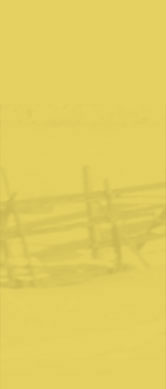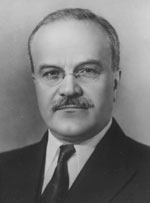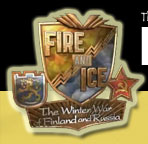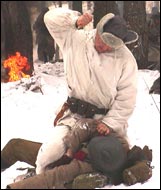

 Joseph
Stalin
Joseph
Stalin
Wikopedia.com
Josef Stalin
Josef
Stalin was born December 18, 1878 to a poor cobbler and serf. His
father had a drinking problem and was abusive,
leaving Stalin with an extreme hatred for authority. At the age
of eight, Stalin began his education at Gori Church School where
he
graduated at the top of his class. He received a scholarship at
the age of 14 to attend Tiflis Theological Seminary. It was here
that
his interest and involvement in the Socialist movement (the branch
that later became Communism), began. He joined a Georgian Social-Democratic
organization and began propagating Marxism. In 1899, he was expelled
from school for his participation.
He worked a decade with the political underground and experienced repeated arrests and was even exiled to Siberia between 1902-1917. He was useful in Lenin’s party because of his experiences, which gained him a place on the Central Committee in January 1912. It wasn’t until 1913, at the age of 35, that he adopted the name Stalin, which means “steel man” in Russian. While Lenin and much of his leadership were in exile, Stalin became editor of Pravda, the official Communist newspaper. In 1917 he was elected to the Central Committee as the Politburo and served in this spot for the remainder of his life.
In April of 1922 he became the general secretary of the Central Committee of the Russian Communist Party, a position that the built up to be the most powerful in the country. He did not achieve full power until the Great Purge of his political and ideological opponents in 1936-1938. This was a time of arrests and executions, which proved to weaken the Soviet Army during the Winter War. Stalin’s involvement in the Winter War was rooted in his anxiety of German expansion, which led to the Nazi Soviet Pact. This pact secretly outlined areas of expansion for each power, which led to the Soviet forces invading Finland in November of 1939.
Stalin was assured by his officials that the invasion would take 10 days, but as the invasion campaign led to weeks and months it was made clear that the Great Purges had severely weaken the effectiveness of the Soviet forces and they had underestimated the Finnish forces. This underestimation was brought to the world attention and Stalin became very conscious of how he was perceived on the world stage at the war continued with the Soviets taking very heavy losses.
An uneasy peace was negotiated between Finland and the Soviet Union and ended the conflict in 1940. During the end of the Winter War Stalin reevaluated his army, which worked to his advantage when Hitler decided to invade the Soviet Union during World War II.
Learn more about Josef Stalin
General Stepan
Ivanovich Kodratjev
The commander of the Soviet 34th Tank Brigade who was part of the Red Army surrounded
by Finnish forces in the East Lemetti Mott. He bravely lead an attack to save
his forces from the Finnish encirclement and was killed in the action.
Otto
Ville Kuusinen
A Finnish red exiled from Finland
after the War Of Independence. His return to Finland took place
when Stalin named
him the head of
the Terijoki government in 1939. This Soviet puppet government
received no support in Finland.
Army Commander
2nd Class K. A. Meretskov
The commander of the Leningrad Military District at the time of the Winter War
who did have his doubts about how the war in Finland might go. He cautioned of
the terrain and how this would effect the Red Army’s movements.
Vyacheslav Mikhailovich Molotov 1890 - 1986

Vyacheslav Molotov
Central State Archive of Photo and Cinema, St. Petersburg
Originally born Vyacheslav Skriabin on March 9, 1890, Molotov joined the Bolsheviks
in 1906. He helped found the party newspaper Pravda, and during the Russian
Revolution of 1917 helped plan the Bolshevik seizure of power. In 1930 - 1941
he was chairman of the Council of People's Commissars (a post equivalent to
prime minister) and in 1939 - 1949 and 1953 - 1956 he served as foreign minister.
He negotiated the Nazi-Soviet Pact of August 1939 and played a key role in
Soviet wartime and postwar relations with the Western powers. A faithful lieutenant
of Josef Stalin, he broke with Stalin's successor Nikita Khrushchev in 1957.
Molotov was dismissed from his government posts and from the party's leading
bodies and named ambassador to Mongolia (1957-60) and representative to the
International Atomic Energy Agency in Vienna (1960-61). In 1962, he was expelled
from the Communist party.
Learn more about Molotov
Marshal Semyon (or Semem) Timoshenko
A World War
I veteran of the Imperial Russian Army he was one of the better
commanders under Stalin who was able to escape the
purges. After the stalled and failed attacks of the Red Army in the
Winter War, Timoshenko was made overall commander of the Soviet forces
in Finland. He regrouped the troops under his command and also stressed
that Red Army forces improve their communications lines as well as
their tactical discipline. He also made the decision to focus the
attack on the Karelian Isthmus as he felt this was the key to taking
Finland. Before taking overall command he informed Stalin that while
the Red Army could win in Finland, Timoshenko wanted to be absolved
beforehand for the losses he knew would come.
Andrei Zhdanov
Zhdanov was made governor of Leningrad after the assignation of Sergei Kirov
in 1934. A political hack of Stalin he was a great supporter of the attacks
directed towards Finland. He told Stalin that the task in Finland would be
easy and could be handled by the forces in the Leningrad Miltary District.





